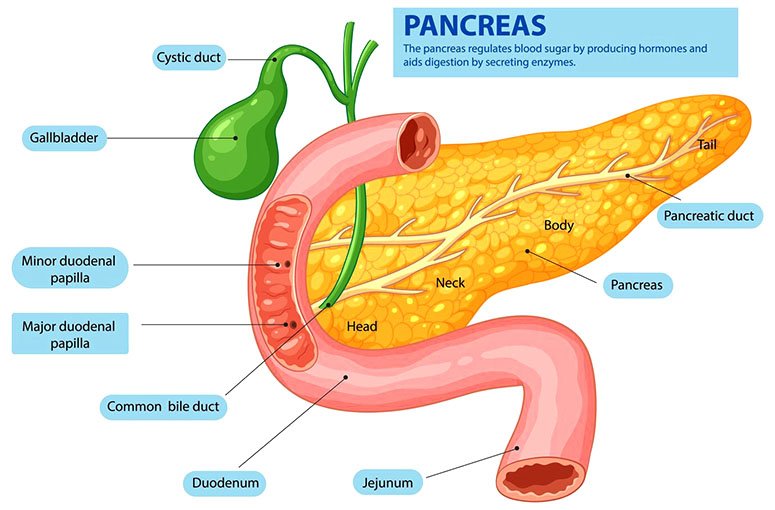Contents
Pancreatic cancer is regarded as one of the most challenging forms of cancer to diagnose and treat, frequently presenting with nonspecific symptoms that may be easily overlooked.
Key symptoms to monitor include jaundice and abdominal pain, as well as the various risk factors associated with this disease.
Understanding the survival rates, including questions like “What are the odds of surviving pancreatic cancer?”, and prevention strategies is essential for making informed decisions regarding one’s health.
Acquiring essential insights into pancreatic cancer, including the odds of surviving the disease, can significantly impact awareness and proactive health management.
What are the symptoms of pancreatic cancer?
Pancreatic cancer is frequently described as a silent disease due to its subtle and easily overlooked symptoms in the early stages.
Recognizing and understanding the symptoms of pancreatic cancer is essential for early detection, which can significantly influence patient outcomes.
While symptoms may vary, they commonly include:
- jaundice;
- abdominal pain;
- unintended weight loss;
- loss of appetite.
Heightened awareness of these symptoms can facilitate timely diagnosis, enabling healthcare professionals to implement effective treatment options and enhance the prognosis for affected individuals.
1. Jaundice
Jaundice is a medical condition characterized by the yellowing of the skin and eyes, often indicative of underlying issues related to the liver or bile ducts. It can be one of the initial noticeable symptoms associated with pancreatic cancer.
As pancreatic cancer advances, it may obstruct the bile duct, resulting in the accumulation of bilirubin in the bloodstream, which subsequently leads to jaundice.
This symptom is not only concerning for the patient but also serves as a vital indicator for healthcare professionals regarding diagnosis and necessary interventions.
With the progression of the tumor, the exacerbation of jaundice can significantly affect the patient’s overall health, both in terms of physical discomfort and psychological distress.
Effective management of this symptom is essential, as the yellowing of the skin and eyes can negatively influence the quality of life.
This situation underscores the importance of timely therapies and supportive care to address both the cancer and the distressing symptoms that accompany it.
2. Abdominal pain

Abdominal pain is a prevalent symptom of pancreatic cancer, typically presenting as discomfort or aching in the upper abdomen, which may radiate to the back.
This pain can be either intermittent or persistent, leading individuals to mistakenly associate it with less severe gastrointestinal disorders or other common ailments.
Due to its nonspecific nature, this symptom can often be misinterpreted as conditions such as gastritis or peptic ulcers, resulting in delays in accurate diagnosis.
Recognizing the distinctive pain associated with pancreatic cancer is essential, as early intervention can considerably influence patient outcomes. Therefore, seeking prompt medical advice is imperative.One common question that arises for many affected individuals and their families is, “What are the odds of surviving pancreatic cancer?”
Addressing such concerns with healthcare providers can help in understanding the disease better and exploring treatment options.
Enhancing healthcare access and patient education can enable individuals to identify concerning signs and understand when it is necessary to consult a healthcare professional for further evaluation.
3. Unintentional weight loss
Unintentional weight loss can serve as a concerning indicator of pancreatic cancer, reflecting the body’s difficulty in absorbing nutrients due to the disease’s effects on the digestive system.
As the cancer advances, individuals frequently undergo significant changes in appetite, resulting in reduced caloric intake that further intensifies weight loss.
The body’s metabolic demands increase as it combats the illness, necessitating greater energy and nutrients than usual, which can be challenging to fulfill when issues with nutritional absorption arise.
Along with these physiological changes, lifestyle modifications, including altered dietary habits, may hinder patients’ ability to maintain their health.
Healthcare professionals are essential in addressing these issues by offering customized nutritional guidance and support to effectively manage symptoms and enhance overall well-being.
4. Loss of appetite
Loss of appetite is a commonly reported concern among patients diagnosed with pancreatic cancer and can have a significant impact on their overall health and quality of life.
This distressing symptom may arise from a combination of physical issues, such as abdominal pain, nausea, and gastrointestinal alterations, alongside psychological factors, including depression and anxiety, which frequently accompany a cancer diagnosis.
The apprehension regarding disease progression or the demands of treatment may cause many individuals to withdraw from meals and social interactions, thereby further reducing their nutritional intake.
Addressing loss of appetite through effective symptom management is essential, as ensuring adequate nutrition not only supports the body during treatment but also enhances overall patient care strategies.
By focusing on improving eating habits, healthcare teams can assist patients in navigating this challenging journey, thereby promoting a better quality of life despite the complexities associated with pancreatic cancer.
What are the risk factors for pancreatic cancer?

Understanding the risk factors associated with pancreatic cancer is crucial for effective prevention and early detection. Significant risk factors include age, smoking, obesity, and family history, all of which can increase an individual’s likelihood of developing this aggressive disease.
By identifying these risk factors, healthcare providers can more effectively assess individual risks, promote awareness campaigns, and implement preventive care strategies that may enhance patient outcomes.
1. Age
Age constitutes a significant risk factor for pancreatic cancer, with the incidence of this disease experiencing a substantial increase after the age of 50.
Extensive research supports this trend, demonstrating that over 70% of pancreatic cancer cases occur in individuals aged 65 and older.
The mortality rate associated with this specific cancer is notably high, with only a small percentage of patients surviving five years following diagnosis.
Current survival statistics indicate that the overall five-year survival rate is approximately 10%, which underscores the challenges healthcare professionals encounter when treating older patients.
As the age of onset rises, it is often associated with poorer patient outcomes, thereby emphasizing the importance of age as a critical factor in the understanding and management of pancreatic cancer.
This leads to the question, “What are the odds of surviving pancreatic cancer?” Understanding these odds helps in assessing prognosis and making informed treatment decisions.
2. Smoking
Smoking has been definitively linked to an increased risk of pancreatic cancer, with smokers exhibiting a two to threefold higher likelihood of developing this disease compared to non-smokers.
This concerning statistic highlights the urgent necessity for effective lifestyle modifications and preventive measures.
Research has demonstrated that carcinogens present in tobacco smoke can directly damage the DNA within pancreatic cells, which can lead to tumor formation.
Additionally, smoking is associated with promoting inflammation and chronic pancreatitis, thereby further elevating the risk of cancer.
As healthcare policies continue to evolve in order to address the prevalence of smoking, awareness campaigns are playing an essential role in educating the public about the dangers of smoking, especially its relationship with pancreatic cancer.
By fostering a culture that prioritizes healthy choices and supports smoking cessation, society can significantly reduce the incidence of this devastating disease.
3. Family History
A family history of pancreatic cancer significantly increases an individual’s risk, highlighting the importance of genetic factors and the necessity for screening in those with a familial predisposition.
In such circumstances, engaging in genetic counseling can offer valuable insights into hereditary syndromes that may further elevate their risk.
Understanding the genetic markers associated with pancreatic cancer can assist both patients and healthcare providers in making informed decisions regarding monitoring and preventive strategies.
For individuals with a strong family history, it’s important to consider what are the odds of surviving pancreatic cancer and how early intervention might improve outcomes.
A multidisciplinary approach through a tumor board can enhance patient care by integrating insights from various specialists, thereby facilitating tailored management plans.
Additionally, patient education is crucial in this process, enableing individuals with knowledge about risk factors, screening options, and the significance of early detection.
4. Obesity
Obesity is a well-recognized risk factor for pancreatic cancer, as excess body weight can induce biological changes that facilitate the development of cancer.
The accumulation of adipose tissue can initiate a series of metabolic effects, including insulin resistance and elevated levels of inflammatory markers, both of which have been associated with the onset of malignancies.
These metabolic disruptions have a significant impact on cellular growth and survival, thereby creating a more favorable environment for tumorigenesis.
Individuals experiencing obesity often find it challenging to maintain a balanced diet, which can further aggravate these issues.
Consequently, adopting lifestyle modifications, such as enhanced nutrition and regular physical activity, is essential for preventive healthcare.
These changes not only aid in weight management but also play a crucial role in reducing the risk of chronic diseases, including pancreatic cancer.
What are the odds Of surviving pancreatic cancer?
The prognosis for individuals diagnosed with pancreatic cancer is substantially influenced by several factors, including the stage of the disease at the time of diagnosis, the available treatment options, and the overall health of the patient.
Survival rates for pancreatic cancer tend to be low, with a five-year survival rate approximately at 10%, positioning it as one of the most difficult cancers to treat.
Early detection is critical for enhancing prognosis, as is access to clinical trials and advancements in treatment modalities, such as chemotherapy, radiation therapy, and immunotherapy.
1. Stage of cancer
The stage of pancreatic cancer at the time of diagnosis is a critical determinant of both the survival rate and the treatment options available to patients.
Patients often confront a challenging reality when faced with the various stages of this disease, as each stage presents distinct challenges and implications for treatment.
Early-stage pancreatic cancer, classified as Stage 1, typically exhibits a higher survival rate, with surgical intervention recognized as the most effective treatment option.
As the disease advances to Stage 2 and beyond, the identification of tumor markers becomes essential for evaluating treatment efficacy and informing clinical decisions.
Regrettably, Stage 3 and Stage 4 pancreatic cancer are associated with more advanced disease progression and significantly lower survival rates.
This highlights the critical importance of early detection and the potential role of targeted therapies in managing this complex and challenging illness.
What are the odds of surviving pancreatic cancer if it reaches these more advanced stages? The prognosis becomes notably more difficult, underscoring the importance of exploring all available treatment options and participating in clinical trials where appropriate.
2. Treatment options
The treatment options for pancreatic cancer vary significantly depending on the stage of the disease and the overall health of the patient.
Common approaches include surgery, chemotherapy, and radiation therapy, with the Whipple procedure frequently employed as a surgical option.
In cases of early-stage pancreatic cancer, surgical intervention typically offers the greatest potential for remission.
Conversely, for patients with more advanced disease, clinical protocols may require a combination of chemotherapy and radiation therapy.
The effectiveness of these treatment modalities is often influenced by patient engagement; a thorough understanding of available options enables individuals to make informed decisions regarding their care.
Palliative care plays a vital role in the management of pancreatic cancer, focusing not only on prolonging life but also on enhancing its quality, particularly as the disease advances and treatment options become increasingly limited.
A tailored approach allows healthcare providers to address both physical symptoms and emotional well-being, thereby ensuring a more holistic and comprehensive care strategy.
3. Overall health and age
A patient’s overall health and age are critical determinants in the prognosis of pancreatic cancer, significantly influencing both treatment options and survival rates.
Younger patients, for example, may be better able to tolerate aggressive treatment regimens compared to older individuals who may have comorbidities.
This highlights the importance of providing tailored healthcare access.
Additionally, the presence of supportive caregivers can have a profound effect on treatment adherence and emotional resilience, as navigating the complexities of this formidable illness can be overwhelming.
Collaborating with patient advocacy groups also enables individuals diagnosed with pancreatic cancer, assisting them in making informed medical choices and ensuring they receive comprehensive support.
Such multifaceted approaches not only enhance the patient experience but also improve potential outcomes, fostering a more favorable environment for recovery.
How can pancreatic cancer be prevented?
Although there is no guaranteed method to prevent pancreatic cancer, implementing specific lifestyle changes and preventive measures can significantly reduce the risk of developing this disease.
Key components of an effective preventive strategy include:
- Maintaining a healthy weight;
- Cessation of smoking;
- Engaging in regular physical activity.
Furthermore, awareness campaigns that emphasize the importance of early detection through routine check-ups and cancer screenings can enhance outcomes for populations at risk.
1. Quit smoking
Quitting smoking represents one of the most significant lifestyle changes that can decrease the risk of developing pancreatic cancer, as tobacco use is directly associated with various types of cancer.
Research indicates that individuals who successfully quit smoking can reduce their risk of developing pancreatic cancer by as much as 50% within five years.
As people consider their health, they may wonder, “What are the odds of surviving pancreatic cancer?” Reducing risk factors such as smoking can significantly improve those odds.
Along with the health benefits, those who decide to quit can access a variety of resources designed to support them throughout this challenging process.
Healthcare professionals are typically available to provide guidance tailored to an individual’s specific needs, while specialized programs may offer financial assistance to alleviate the costs associated with cessation aids.
Furthermore, emotional support groups are accessible to facilitate the sharing of experiences and strategies, fostering a sense of community among individuals on a similar journey.
2. Maintain a healthy weight

Maintaining a healthy weight is crucial for reducing the risk of pancreatic cancer, as obesity is a recognized risk factor associated with this disease.
Research demonstrates that excess body fat can affect inflammation and insulin levels, both of which are linked to the progression of cancer.
Consequently, individuals who aim to lower their risk should prioritize effective weight management strategies that extend beyond mere calorie counting.
By emphasizing balanced nutrition – incorporating a variety of fruits, vegetables, whole grains, and lean proteins—individuals can establish a dietary framework conducive to sustained weight loss.
Additionally, lifestyle modifications such as regular physical activity, stress reduction techniques, and proper sleep hygiene are essential components of chronic disease management.
Implementing these comprehensive practices not only aids in achieving a healthy weight but also enhances overall well-being, thus illustrating the intricate relationship between lifestyle choices and cancer risk.
This holistic approach can improve one’s health outlook and potentially impact answers to questions like, “What are the odds of surviving pancreatic cancer?”
3. Eat a balanced diet
Consuming a balanced diet that is rich in fruits, vegetables, whole grains, and healthy fats can significantly reduce the risk of pancreatic cancer while enhancing overall health.
This highlights the critical importance of making informed lifestyle changes, as these dietary practices play a vital role in cancer prevention.
Specifically, the inclusion of foods such as leafy greens, berries, nuts, and legumes can provide essential nutrients and antioxidants that strengthen the immune system.
Support systems for patients, which include healthcare professionals and nutritionists, can assist individuals in making these advantageous dietary choices.
Additionally, engaging with community resources, such as local farmers’ markets and cooking classes, can create an environment that encourages healthy eating habits, ultimately contributing to a diminished risk of cancer and improved well-being over time.
4. Regular exercise
Regular exercise is an essential component of a healthy lifestyle and can significantly reduce the risk of pancreatic cancer by aiding in weight management and enhancing metabolic health.
Engaging in physical activity not only improves physical fitness but also supports mental well-being, positioning it as a crucial element in cancer prevention strategies.
It is advisable to incorporate a combination of aerobic exercises, strength training, and flexibility workouts, with a recommendation of at least 150 minutes of moderate-intensity exercise per week.
These lifestyle modifications contribute positively to healthcare access and patient outcomes, as they enable individuals to take control of their health.
Consistent physical activity can lead to improved immune function and hormonal balance, further mitigating cancer risks and promoting overall health.
5. Regular check-ups and screenings
Regular check-ups and screenings are essential for the early detection of pancreatic cancer, particularly for individuals at high risk.
These proactive measures can facilitate timely diagnosis and improve treatment outcomes.
In contemporary healthcare systems, the integration of various cancer screening methods is critical in managing this aggressive disease.
These methods may encompass imaging tests such as CT scans or MRIs, in addition to blood tests including the CA19-9 tumor marker.
Patient engagement is a vital component of this process, as being informed and proactive regarding one’s risk factors enables individuals to actively participate in discussions about their health with medical professionals.
This collaborative approach not only increases the likelihood of early detection of pancreatic cancer but also cultivates a supportive environment for patients as they navigate their healthcare journey.
Our FAQ, located further down the page, provides details on the likelihood of surviving pancreatic cancer.
Dive into the captivating realm of probabilities and rare events. Feed your curiosity and discover more intriguing subjects by exploring our other articles at WhatAreTheOddsOf.NET.



